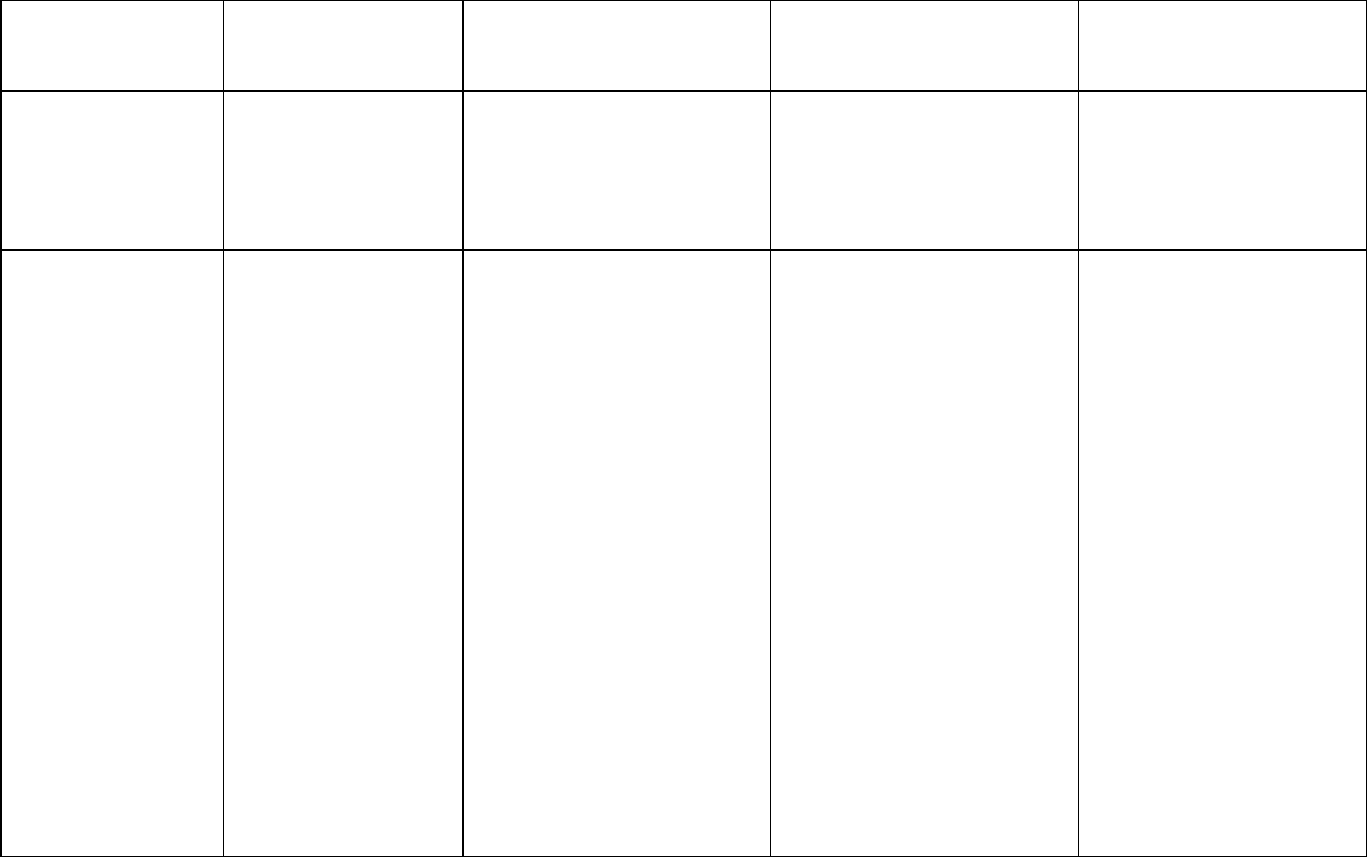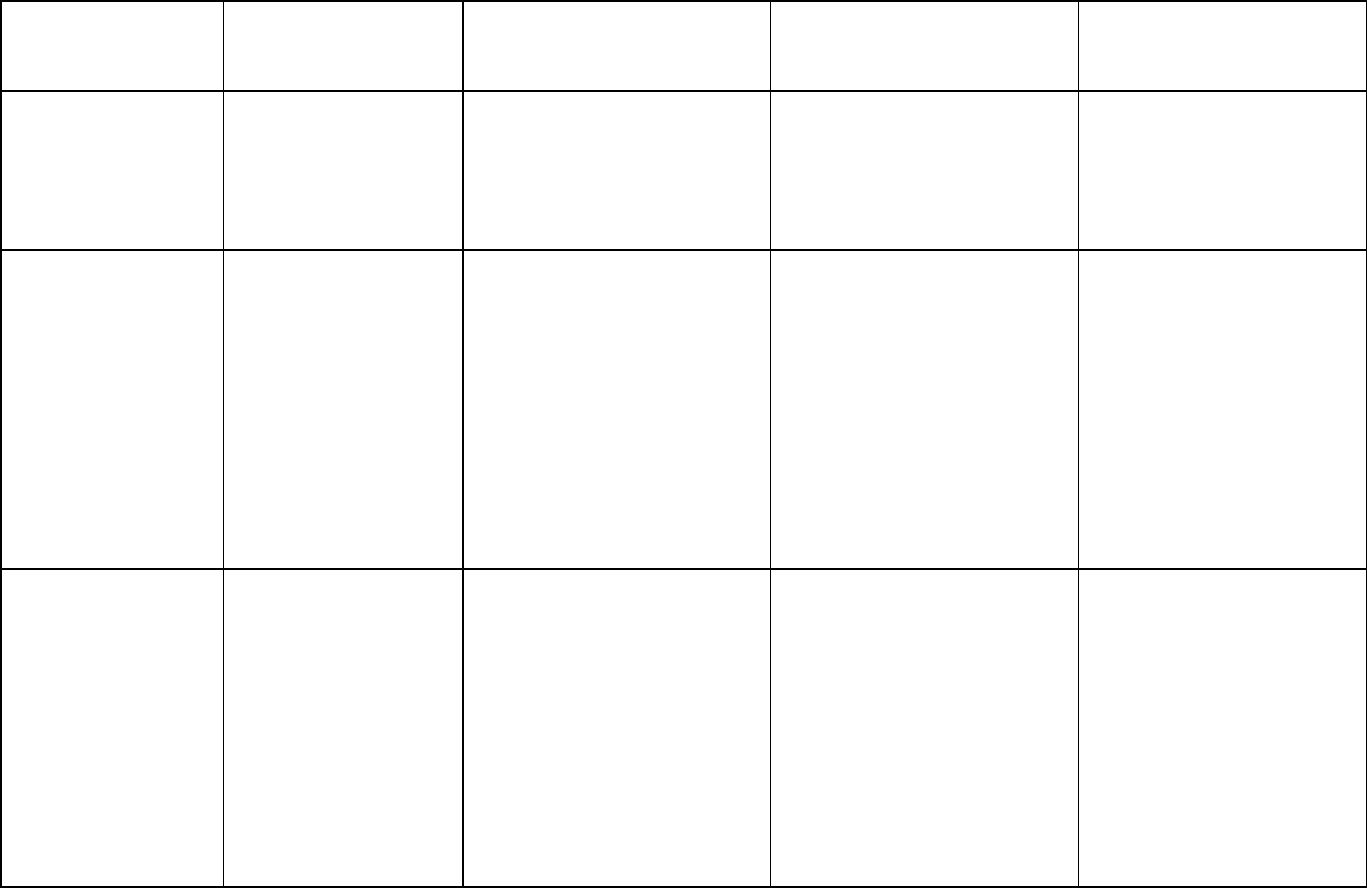
W.K. Kellogg Foundation/Mosaica Page 1
Using the Logic Model for Program Planning
Many tools can help you do a good job of planning, documenting, and evaluating your projects.
One of these tools is the “Logic Model.” Developed primarily as an evaluation tool, it is also a
wonderful tool to guide project planning, documentation, and reporting, as well as program
implementation, monitoring, and evaluation. It is an excellent “fit” with the Technology
Initiative Grant (TIG) Evaluation Plan Framework.
The rest of this section explains what a Logic Model is and how you can use it for program
planning. The basic descriptive information comes directly from The Logic Model Development
Guide, prepared for the W.K. Kellogg Foundation. (To order a free copy of the Guide or to
download it in PDF format, go to the Foundation’s website at
http://www.wkkf.org, and click on
“Evaluation” under “Toolkits” on the right side of the home page, or go to
http://www.wkkf.org/Pubs/Tools/Evaluation/Pub3669.pdf.) Mosaica has added some examples
and references that relate the Logic Model to your TIG project plans; those additions are in
Italics.
Understanding the Logic Model
1
The introduction to the Logic Model Development Guide defines the Logic Model concept and
explains some of its benefits:
The program Logic Model is defined as a picture of how your organization [or project]
does its work – the theory and assumptions underlying the program. A program Logic
Model links outcomes (both short- and long-term) with program activities/ processes
and the theoretical assumptions/ principles of the program.
The W.K. Kellogg Foundation Logic Model Development Guide, a companion
publication to the Evaluation Handbook,
2
focuses on the development and use of the
program Logic Model. We have found the Logic Model and its processes facilitate
thinking, planning, and communications about program objectives and actual
accomplishments. Through this guide, we hope to provide an orientation to the
underlying principles and language of the program Logic Model so it can be effectively
used in program planning, implementation, and dissemination of results….
Learning and using tools like Logic Models can serve to increase the practitioner’s voice
in the domains of planning, design, implementation, analysis, and knowledge generation.
The process of developing the model is an opportunity to chart the course. It is a
conscious process that creates an explicit understanding of the challenges ahead, the
resources available, and the timetable in which to hit the target. In addition, it helps keep
a balanced focus on the big picture as well as the component parts.
In general, Logic Modeling can greatly enhance the participatory role and usefulness of
evaluation as a management and learning tool. Developing and using Logic Models is an
1
The information in this subsection comes directly from the Logic Model Development Guide, and was excerpted by
Mosaica with permission from the W.K. Kellogg Foundation.
2
This guide is available on the same website as the Logic Model Development Guide, www.wkkf.org.

W.K. Kellogg Foundation/Mosaica Page 2
important step in building community capacity and strengthening community voice. The
ability to identify outcomes and anticipate ways to measure them provides all program
participants with a clear map of the road ahead. Map in hand, participants are more
confident of their place in the scheme of things, and hence, more likely to actively engage
and less likely to stray from the course – and when they do, to do so consciously and
intentionally. Because it is particularly amenable to visual depictions, program Logic
Modeling can be a strong tool in communicating with diverse audiences – those who
have varying world views and different levels of experience with program development
and evaluation
….
The What and Why of the Logic Model
The WHAT: Logic Model Definition
Basically, a Logic Model is a systematic and visual way to present and share your
understanding of the relationships among the resources you have to operate your
program, the activities you plan to do, and the changes or results you hope to achieve.
Figure 1. The Basic Logic Model.
Resources/
Inputs
Ä
Activities
Ä
Outputs
Ä
Outcomes
Ä
Impact
1 2 3 4 5
_______________________________ _______________________________________________________
Your Planned Work Your Intended Results
The most basic Logic Model is a picture of how you believe your program will work. It
uses words and/or pictures to describe the sequence of activities thought to bring about
change and how these activities are linked to the results the program is expected to
achieve.
The Basic Logic Model components shown in Figure 1 above are defined below. These
components illustrate the connection between your planned work and your intended results. They
are depicted numerically by steps 1 through 5.
YOUR PLANNED WORK describes what resources you think you need to implement your
program and what you intend to do.
1. Resources include the human, financial, organizational, and community resources a program
has available to direct toward doing the work. Sometimes this component is referred to as Inputs.
2. Program Activities are what the program does with the resources. Activities are the processes,
tools, events, technology, and actions that are an intentional part of the program implementation.
These interventions are used to bring about the intended program changes or results.

W.K. Kellogg Foundation/Mosaica Page 3
YOUR INTENDED RESULTS include all of the program’s desired results (outputs, outcomes,
and impact).
3. Outputs are the direct products of program activities and may include types, levels and targets
of services to be delivered by the program. [In a TIG project, your outputs are statements of your
“process” objectives, the measures used to show that you have completed the activities you have
identified as necessary to achieve your goals.]
4. Outcomes are the specific changes in program participants’ behavior, knowledge, skills, status
and level of functioning. Short-term outcomes should be attainable within 1-3 years, while
longer-term outcomes should be achievable within a 4-6 year timeframe. The logical progression
from short-term to long-term outcomes should be reflected in impact occurring within about 7-10
years. [The short-term and medium-term outcomes are your project objectives – in the TIG
Evaluation Framework, they are often included as bullets below your broad project goal.]
5. Impact is the fundamental intended or unintended change occurring in organizations,
communities or systems as a result of program activities within 7-10 years. In the current model
of WKKF grantmaking and evaluation, impact often occurs after the conclusion of project
funding. [The desired impact is your project’s goals].
The term Logic Model is frequently used interchangeably with the term program theory in the
evaluation field. Logic models can alternatively be referred to as theory because they describe
how a program works and to what end.
The What: How to “Read” a Logic Model
When “read” from left to right, Logic Models describe program basics over time from planning
through results. Reading a Logic Model means following the chain of reasoning or “If...then...”
statements which connect the program’s parts. The figure below shows how the basic Logic
Model is read.
Figure 2. How to Read a Logic Model.
Certain
resources are
needed to
operate your
program
If you have
access to
them, then you
can use them
to accomplish
your planned
activities
If you
accomplish
your planned
activities, then
you will
hopefully deliver
the amount of
product and/or
service that
you intended
If you
accomplish
your planned
activities to the
extent you
intended, then
your participants
will benefit in
certain ways
If these
benefits to
participants are
achieved, then
certain changes
in organizations,
communities,
or systems
might be
expected to
occur
Resources/
Inputs
Ä
Activities
Ä
Outputs
Ä
Outcomes
Ä
Impact
1 2 3 4 5
_______________________________ _________________________________________________________
Your Planned Work Your Intended Results
W.K. Kellogg Foundation/Mosaica Page 4
The WHY: Logic Model Purpose and Practical Application
The purpose of a Logic Model is to provide stakeholders with a road map describing the
sequence of related events connecting the need for the planned program with the
program’s desired results. Mapping a proposed program helps you visualize and
understand how human and financial investments can contribute to achieving your
intended program goals and can lead to program improvements. A Logic Model brings
program concepts and dreams to life. It lets stakeholders try an idea on for size and apply
theories to a model or picture of how the program would function….
Why Use a Logic Model?
…Logic models are useful tools in many ways. Because they are pictorial in nature, they
require systematic thinking and planning to better describe programs. The visual
representation of the master plan in a Logic Model is flexible, points out areas of strength
and/or weakness, and allows stakeholders to run through many possible scenarios to find
the best. In a Logic Model, you can adjust approaches and change courses as program
plans are developed. Ongoing assessment, review, and corrections can produce better
program design and a system to strategically monitor, manage, and report program
outcomes throughout development and implementation.
Effective evaluation and program success rely on the fundamentals of clear stakeholder
assumptions and expectations about how and why program will solve a particular
problem, generate new possibilities, and make the most of valuable assets. The Logic
Model approach helps create shared understanding of and focus on program goals and
methodology, relating activities to projected outcomes.
Logic Models Better Position Programs For Success
Many evaluation experts agree that use of the Logic Model is an effective way to ensure
program success. Using a Logic Model throughout your program helps organize and
systematize program planning, management, and evaluation functions.
1. In Program Design and Planning, a Logic Model serves as a planning tool to develop
program strategy and enhance your ability to clearly explain and illustrate program
concepts and approach for key stakeholders, including funders.
Logic models can help craft structure and organization for program design and build in
self-evaluation based on shared understanding of what is to take place. During the
planning phase, developing a Logic Model requires stakeholders to examine best practice
research and practitioner experience in light of the strategies and activities selected to
achieve results.
2. In Program Implementation, a Logic Model forms the core for a focused management
plan that helps you identify and collect the data needed to monitor and improve
programming.

W.K. Kellogg Foundation/Mosaica Page 5
Using the Logic Model during program implementation and management requires you to
focus energies on achieving and documenting results. Logic models help you to consider
and prioritize the program aspects most critical for tracking and reporting and make
adjustments as necessary.
3. For Program Evaluation and Strategic Reporting, a Logic Model presents program
information and progress toward goals in ways that inform, advocate for a particular
program approach, and teach program stakeholders.
We all know the importance of reporting results to funders and to community stakeholders alike.
Communication is a key component of a program’s success and sustainability. Logic models can
help strategic marketing efforts in three primary ways:
• Describing programs in language clear and specific enough to be understood and evaluated.
• Focusing attention and resources on priority program operations and key results for the
purposes of learning and program improvement.
• Developing targeted communication and marketing strategies.
The Table below describes the relationship between a successful program and the benefits
derived from the use of Logic Models.
How Logic Models Better Position Programs Toward Success.
Program
Elements
Criteria for Program Success
3
Benefits of Program Logic
Models
4
Program goals and objectives, and
important side effects are well defined
ahead of time.
Finds “gaps” in the theory or logic of a
program and work to resolve them.
Planning & Design
Program
Program goals and objectives are both
plausible and possible.
Builds a shared understanding of what
the program is all about and how the
parts work together.
Implementation &
Management
Relevant, credible, and useful
performance data can be obtained.
Focuses attention of management on
the most important connections
between action and results.
Evaluation,
Communication, &
Marketing
The intended users of the evaluation
results have agreed on how they will
use the information.
Provides a way to involve and engage
stakeholders in the design, processes,
and use of evaluation.
[This ends the material excerpted from the Logic Model Development Guide.]
3
Wholey, J. S., Hatry, H. P., & Newcomer, K. E. (Eds.). (1994). Handbook of Practical Program Evaluation.
San Francisco: Jossey-Bass Publishers.
4
Barley, Z., Phillips, C., & Jenness, M. (1998). Decoding Program Logic Models. Workshop presented at the
Annual Meeting of the American Evaluation Association, Chicago, IL, November, 1998.

Using the Logic Model for Project Planning and Proposal Development
Developing a logic model can help you plan a project and prepare a sound proposal. When you
are planning a project, bring together key partners and use a logic model format to describe your
project. Doing this as a team can help ensure a shared understanding of desired short- and
longer-term outcomes, and the tasks and activities and resources needed to reach them. United
Way of America has encouraged the use of logic models among local United Way service
agencies for nearly a decade.
There are many formats and approaches to logic models. The basic logic model format, as
presented above, is based on a set of “if…then” assumptions that emphasize how the different
cells in a logic model relate to each other. The Guide describes them as follows:
IF…THEN Assumptions from the Logic Model Development Guide:
• Certain resources are needed to operate your program.
• If you have access to them, then you can use them to accomplish your planned activities.
• If you accomplish your planned activities, then you will hopefully deliver the amount of product
and/or service that you intended.
• If you accomplish your planned activities to the extent intended, then your participants will
benefit in specific ways.
• If these benefits to participants are achieved, then certain changes in organizations, communities,
or systems might occur under specified conditions.
Perhaps the most commonly used logic model format is the one presented in the Introduction,
which connects resources and activities with desired outputs and outcomes. In preparing a Logic
Model, you can start at either end. Rather than going left to right, you can begin at the right. For
example, perhaps you know what you want to achieve in the long run. Start by describing the
long-term impact you seek, and move to the left. You can identify the shorter-term outcomes that
will measure progress towards that impact. Then you can decide on the activities and outputs that
will help you reach these outcomes. Finally, you can decide what cash and non-cash (“in-kind”)
resources you will need in order to carry out the program.
You may find additional formats useful. For example, before completing the logic model format
presented here, you may want to use a “Planning Template” that helps you identify and examine
the following:
• The problem(s) or issues your project needs to address
• The needs or assets of your community – such as the client barriers that prevent access to
justice
• The results you expect to achieve – outcomes, outcomes, and impact – for your clients,
organization, and the community
• Factors you believe will influence change in your organization and community
W.K. Kellogg Foundation/Mosaica Page 6
W.K. Kellogg Foundation/Mosaica Page 7
• Promising strategies or “best practices” that have helped other legal services programs to
achieve the kinds of results you are hoping to accomplish
• Assumptions behind how and why you believe those strategies will work in your
organization or community
There are many logic model approaches and no one approach is best. Try using the logic model,
download the Logic Model Development Guide for examples, and guidance, and decide what
approach works best for your organization and your specific project. The two formats described
here are attached to this document.
A Sample Completed Logic Model
Following is a Logic Model that describes a mythical pro se program for low-income individuals
in Rural-State, USA.

Sample Logic Model for the Mythical Rural-State Pro Se Project
Resources/
Inputs
Activities Outputs Outcomes Impact
X% of salaries of staff
attorney
Y% of salary of paralegal
Z% of salary of secretary
W% of salary for
technology director
$Y for consultant help in
developing forms and
packets
Purchase of computers,
related hardware, and
software
Communications costs
In-state travel costs
Training expenses
Operating costs
Train and prepare
attorneys and paralegals
for pro se assistance to
clients
Develop simplified court
forms and packets for
common civil legal
problems
Provide client tutorials,
training, and individual
assistance on use of forms
Develop community
computer access
Develop on-line access
to materials and pro se
assistance
Work with court system
X number of attorneys and Y
number of paralegals trained
Development of X number
of simplified court forms and
packets covering common
legal problems related to the
following civil areas: public
entitlements, housing,
consumer rights, and
employment
Completion of
training/tutorials to X number
of clients
Community computer access
arranged in 15 locations
throughout the state
Technology selected to make
possible on-line access
Short-term (by end of project):
A pro se project will be established at the
Low-Income Legal Clinic to assist low-
income individuals in representing
themselves in court for various civil legal
matters
Simplified court forms and packets will be
available on-line for the most common legal
problems, including rights to public
entitlements, housing, consumer rights, &
employment
Low-income clients will have the computer
skills to access and use simplified court
forms and packets
Low-income clients will be familiar with
civil court processes
Longer-term (within 5 years):
Courts will have written guidelines on
court protocol for clients acting pro se to
assist them with court appearances
Low-income clients will feel empowered to
represent themselves in various civil matters
The number of low-income individuals
who choose to represent themselves in
selected civil matters will have increased by
X% per year
Long-term (within 7-
10 years):
Low-income people
will commonly and
successfully represent
themselves in court
on simple civil
matters
Courts will have
systems and protocols
in place to support
pro se
representation
A system will be in
place to ensure that
each pro se case
receives on-line
support from
paralegals and
attorneys from initial
request through
satisfactory resolution
and record keeping
W.K. Kellogg Foundation/Mosaica Page 8

Logic Model Format
Resources/
Inputs
Activities
Outputs
Outcomes
Impact
In order to
accomplish desired
activities, we need the
following resources:
In order to address the
identified problem and
reach desired outcomes,
we will need to carry
out the following
activities
By accomplishing the stated
activities, we will produce the
following outputs:
Accomplishing these activities
will lead to the following
changes in the short term (1-3
years) and in the longer term
(4-6 years):
Accomplishing these
activities will lead to the
following changes in the long
term (perhaps 7-10 years):
W.K. Kellogg Foundation/Mosaica Page 9

Resources/
Inputs
Activities
Outputs
Outcomes
Impact
In order to
accomplish desired
activities, we need the
following resources:
In order to address the
identified problem and
reach desired outcomes,
we will need to carry
out the following
activities
By accomplishing the stated
activities, we will produce the
following outputs:
Accomplishing these activities
will lead to the following
changes in the short term (1-3
years) and in the longer term
(4-6 years):
Accomplishing these
activities will lead to the
following changes in the long
term (perhaps 7-10 years):
W.K. Kellogg Foundation/Mosaica Page 10

Planning Template
PROBLEM OR ISSUE
COMMUNITY NEEDS/ASSETS
DESIRED RESULTS:
Outputs
Outcomes
Impact
INFLUENTIAL FACTORS
STRATEGIES OR BEST PRACTICES
ASSUMPTIONS
W.K. Kellogg Foundation/Mosaica Page 11
